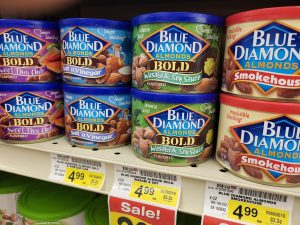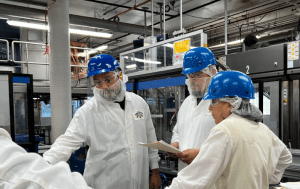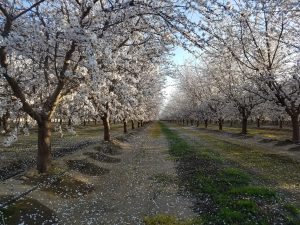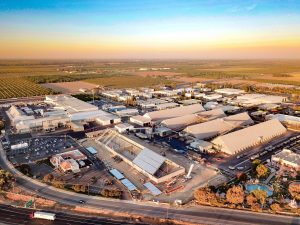When Mark Jansen announced last year he would step down after 12 successful years as president and CEO of Blue Diamond Growers, it was clear he would leave big shoes to fill.
During his tenure, Blue Diamond became one of the fastest-growing food and beverage companies in the world, achieving net sales of $1.6 billion in 2021.
Jansen also led Blue Diamond to enlarge and upgrade its manufacturing facilities in Turlock and Salida, Calif. Under his leadership, Blue Diamond expanded into five new almond product categories and created a global network of licensee partners for Almond Breeze, the world’s top almond milk brand. Perhaps most telling, the co-op achieved double-digit annual growth in its overall branded business.

Finding a replacement for Jansen would be no small task. All eyes turned to Blue Diamond’s 11-member board of directors and its chairman, Dan Cummings. As with any cooperative board, hiring the top manager is a key responsibility. A nationwide search began.
On Dec. 12, Blue Diamond announced it had selected Kai Bockmann as its next president and CEO, with a starting date of Jan. 17. Just two days after the December announcement, Cummings shared with West Coast Nut how the almond company sought and found its new leader, and what he sees as the road ahead for the world’s leading almond marketer and processor.
Cummings, who holds an MBA from Harvard, has served as Blue Diamond’s board chairman since 2014. He also farms 1,100 acres of almonds and 200 acres of walnuts in the Chico, Orland and Arbuckle areas of California’s northern Central Valley.

Q. Blue Diamond’s board recently hired Kai Bockmann as the co-op’s new CEO. How difficult was the selection process? Why did you ultimately choose him, an almond outsider?
The search went very well. We selected Egon Zehnder as our recruiting agency to assist us, and they were fantastic. We had a lot of good candidates. Kai was identified very early in the process and made the selection pretty easy because he’s uniquely well suited to the needs of Blue Diamond going forward. He’s from outside the almond industry, but he’s certainly not outside ag. He spent the first 16 years of his career with McCain Foods, the world’s largest producer of frozen potatoes. And then 10 years with Saputo, one of the world’s largest dairy companies based out of Canada. He’s accustomed to agriculture and farmers. We were fortunate the process went very well and relatively quickly; five months from beginning to end.
Q. How many candidates for the position?
We reviewed well over 100. A lot of them ruled themselves out for various reasons. The pool kept getting smaller and smaller. Then we got down to interviews and then second interviews. The entire board was involved with the interviews of the last three candidates. It was a very methodical, disciplined process, with a great outcome that we’re all excited about.
Q. Apart from his professional resumé, what is Mr. Bockmann like?
He’s very charismatic. He has a very nice demeanor, very comfortable, confident, articulate, bright. He’s a wonderful person.
Q. What goals or expectations did you share with him?
We reviewed the 112-year history of Blue Diamond, what we’ve done, where we are. We reviewed what Mark has accomplished in his last 12 years. The board had developed a consensus of expectations as we looked for a new CEO. A large part of that was to continue the remarkable growth Blue Diamond has had. We’re constantly developing innovative, new uses for almonds. We want to pursue that. There’s a lot of opportunity for international sales. Kai has a real depth of background and experience in international.

Q. What are your specific priorities for 2023 as an almond grower and as Blue Diamond’s board chairman?
As an almond grower, the strategic imperative is to keep my input costs down and the trees growing well while I’m waiting for the price to recover.
At Blue Diamond, it’s going to be an exciting time. I’m looking forward to our offsite strategic planning retreat in May, bringing in Kai with his different background, experiences and industry knowledge, and taking a fresh look at where we are and where we can go, where the opportunities are best, and where best to deploy our resources. Onboarding our new CEO is a big goal for this coming year. We’re fortunate Mark’s staying on for a bit. Mark’s been wonderful to work with and is willing to stay on as long as we need to onboard Kai and get him off to a great start. So, we’re going to have the benefit of two great CEOs for a period of time. It’s led to a seamless transition, which is invaluable.

Q. What needs to be fixed in California’s almond industry, and what are the solutions?
Unfortunately, probably the No. 1 solution is the low prices. They’re going to stimulate demand. The problem is we grew in a surge. We were producing around 2.3, 2.4 billion pounds, and then we jumped to 3.1 billion pounds two years ago. What resulted is a very large carryout supply. We as an industry are shipping about 50 million pounds of almonds a week. Our carryout this year was over 900 million pounds, which is 18 weeks of shipments. We need to get down to 10 to 12 weeks of shipments for the prices to go back up. We need to draw down that supply, which was exacerbated by shipping and logistical problems. Those resulted in lost consumption, which we’ll never regain.
And then tariffs. There were some retaliatory tariffs instituted a few years ago. We need to get those tariffs back down, particularly in India and China, to be able to ship more almonds. Australia enjoys a great advantage because they have no tariffs going into India or China as we do.

Q. Blue Diamond beat the return-to-growers average of its eight closest competitors by 27 cents this year, and 25 cents last year. How did you achieve that?
We’re obviously real proud of that. We did it through good decision-making and execution through our iconic brand, all of our value-added products and the international sales we have, which we intend to build upon. And a lot of great employees with a lot of knowledge who bleed Blue Diamond blue. I can’t say enough about our 1,800 employees and how thankful our 3,000 grower-owners are for all that they do.

Q. Anything to add?
The almond industry is going to recover in the next couple of years. I was just at the Almond Board of California’s annual conference in Sacramento last week. I saw a lot of great presentations. I really appreciate all the work the Almond Board has done on behalf of the industry. And certainly, Blue Diamond pioneering the development of new and innovative uses for almonds and new markets. That’s what’s going to pull us back up to where we’re making money again. We’ve got to draw down that supply and continue to build demand. It’ll happen. We have to be patient. It’s going to take a year or two. But it’s coming, and I’m excited for the future.

















